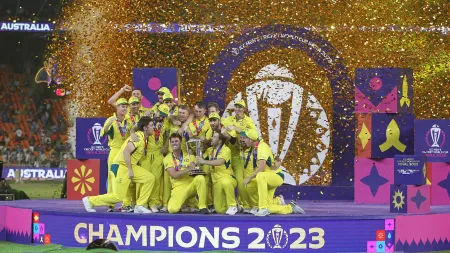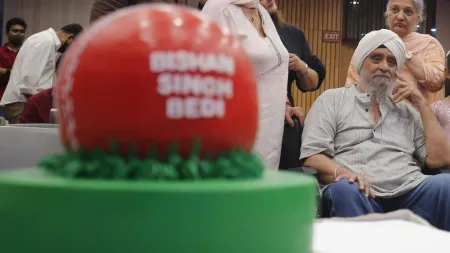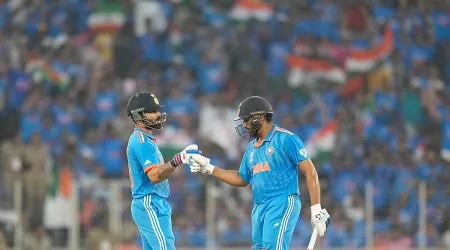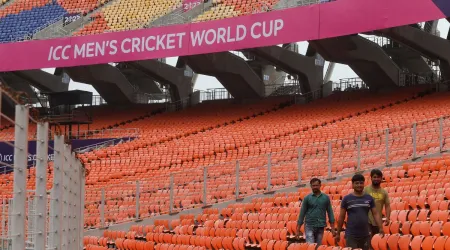- India
- International
Baghpat: Hotbed of India’s shooters of tomorrow
A third of India’s nine medals in shooting at the just-concluded Asian Games came from hours of practice at ranges in western Uttar Pradesh. The Indian Express travels to the region where guns have for long been part of everyday life. Just that they have now learnt to aim right
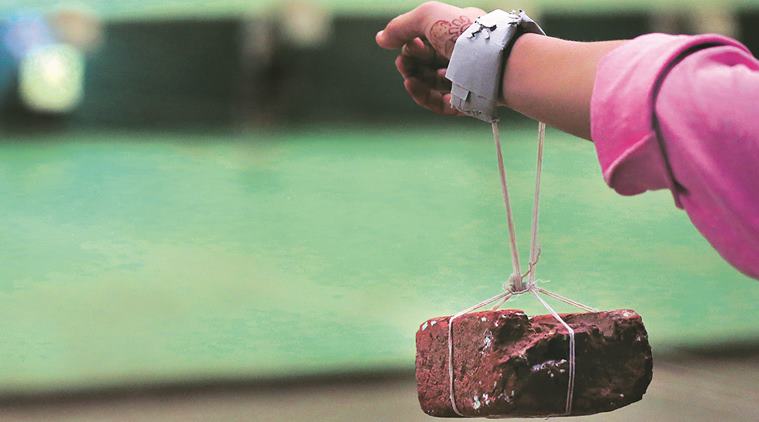 Keeping steady: Coaches suspend bricks from the wrists of the aspiring shooters to ensure they keep their hands steady for long (Express photo by Tashi Tobgyal)
Keeping steady: Coaches suspend bricks from the wrists of the aspiring shooters to ensure they keep their hands steady for long (Express photo by Tashi Tobgyal)
Mansoor Lambardar is the oldest man living in the oldest house in Johri, a village in Uttar Pradesh’s Baghpat district. But that’s not the only reason he’s respected around here.
It’s in the courtyard of the 100-year-old’s 150-year-old house — next to a century-old mosque and under a supposedly 80-year-old peepal tree — that one of the biggest revolutions in Indian shooting began 20 years ago. It was gradual at first, almost unnoticed. Today, it’s a conveyor belt for some of India’s finest shooters, part of a journey that has turned Baghpat, Meerut and their neighbouring districts in western Uttar Pradesh into a hotspot for Indian shooting.
Back in the 1990s, Baghpat had no industries, just lush sugarcane farms and scattered brick fields. These were owned by a few, while the majority worked for low wages. Dacoity was a social problem and easy access to country-made weapons only made it worse.
“Baghpat baaghiyon ka zilla tha (Baghpat was a district of rebels),” says Dr Rajpal Singh, a Johri native who retired from AIIMS a decade ago and now shuttles between Delhi and his village. “But these youngsters were rebels without any cause.”
Asian Games 2018: Complete look at India’s performance in Jakarta and Palembang

His association with shooting began at the 1982 Asian Games, where he was one of the dope-control officers at Delhi’s Dr Karni Singh Shooting Range. Before the end of that decade, he became a certified shooting coach and trained his son Vivek, who went on to become a Commonwealth Games gold medalist and an Arjuna awardee.
In 1998, Rajpal decided to do something else. “The youngsters in Johri were already exposed to guns, so I thought why not drag them to a shooting range,” he says. His logic was simple: country-made pistols are heavier and tougher to operate, and if they could deal with the recoil of those weapons, handling an air-pistol would be effortless.
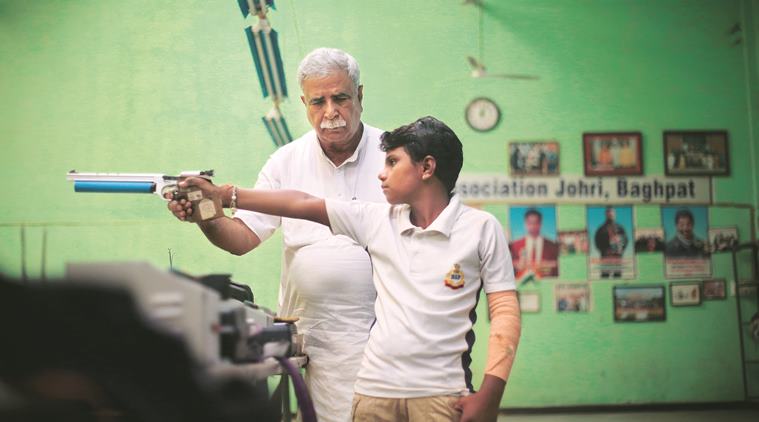 Coach Rajpal Singh assists nine-year-old Doli Jatav at the Johri academy in Baghpat. (Express photo by Tashi Tobgyal)
Coach Rajpal Singh assists nine-year-old Doli Jatav at the Johri academy in Baghpat. (Express photo by Tashi Tobgyal)
Johri, though, didn’t have any ranges. So he approached Lambardar, an influential landlord and sugarcane farmer. A makeshift range with eight firing points was constructed in Lambardar’s courtyard.
This was the easy bit. Convincing villagers was tough — not because they didn’t want to shoot, but the majority of Hindus were uncomfortable sending their children to a Muslim’s house. Rajpal found a way out. “No one listens to their fathers here, but respects their brothers. So we started approaching children through them — if one agreed, the other would follow,” says Rajpal.
For the next 17 years, Lambardar’s haveli resounded with the boom of guns fired by young boys and girls, some of whom would go on to become champions. In July 2015, the academy moved to a bigger space nearby. “Nishana lagana toh yahan seekhe… tamancha toh koi bhi pakad leta (They learnt how to aim here… anyone can hold a pistol),” says Lambardar.
***
If Baghpat’s shooting history can be traced to its mean streets, in Meerut, less than 50 km from Baghpat, the sport flourished in its dense forests, part of a centuries-old hunting culture.
In Meerut, they talk about shooting as an art. A hobby of the nawabs, a tradition that was passed on from one generation to another. Weapons are “jewels” and it’s not about how many targets you shoot down, but how beautifully you can do it.
“Nishane ko khubsurati se kaise mitate hai, yeh toh yahan ke logon ki paidaishi kala hai (Here, we are born with the art of demolishing a target beautifully),” says former India shooter Syed Mohammad Hadi, 61, taking a sip of his milky coffee after he has shot down an imaginary target with his right hand.
He goes on to narrate a story involving a former Pakistani hockey captain: sometime in 1972, he says, Pakistan legend Islah-ud-Din Siddique visited Meerut, his birthplace. One evening, Hadi took him hunting in his jeep. Siddique set his sights on a partridge but it turned out that one of hockey’s fiercest poachers wasn’t quite up to scratch in hunting. He hit the partridge on the wing. Siddique could have had another go at it. But the right-winger, known for his blinding speed, chose another option. “The bird was running away from us at great speed. So he stepped out of the car, chased it down and caught it with the butt of his rifle — just like he’d stop a running ball with his hockey stick,” Hadi says. “We had a great feast that evening.”
A few months later, hunting was declared illegal. “But our love for shooting remained. Just that it is now for clay targets,” says Hadi son’s Ali, a former India shooter.
***
Meerut and Baghpat, regions rife with crime, may have had very contrasting reasons for picking up the sport, but what binds them is their love for guns — some legal, most of it through illegal channels. As per government statistics, western UP has the maximum number of illegal weapons and deaths because of it.
According to the National Crime Records Bureau figures, of nearly 3 lakh cases of illegal arms possession registered in the country between 2010 and 2014, UP accounted for 1.5 lakh. The state also accounts for 40 per cent of all deaths from gun violence in India, with 6,929 people dying in the same period.
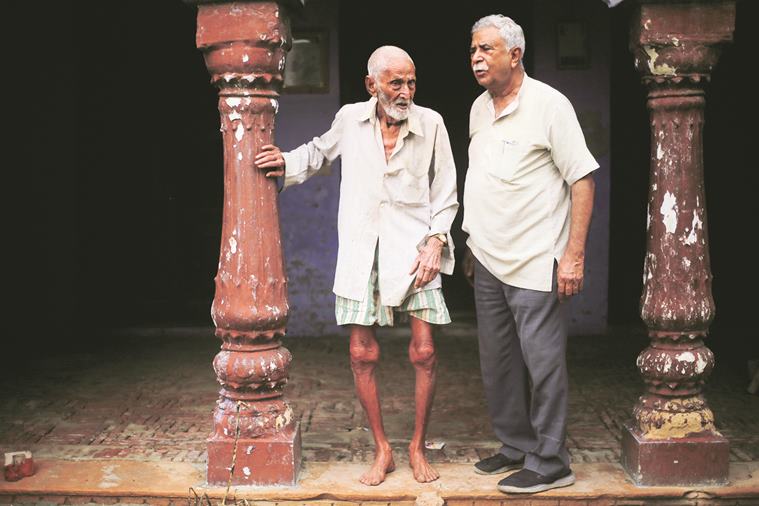 Mansoor Lambardar (left) and coach Rajpal Singh at the former’s haveli in Uttar Pradesh’s Baghpat district, where the first shooting range was set up almost two decades ago. (Express photo by Tashi Tobgyal)
Mansoor Lambardar (left) and coach Rajpal Singh at the former’s haveli in Uttar Pradesh’s Baghpat district, where the first shooting range was set up almost two decades ago. (Express photo by Tashi Tobgyal)
From these badlands, an army of gun-toting, teenaged shooters has risen and they are now scripting a western classic of their own. Two of India’s youngest medalists at the Jakarta-Palembang Asian Games are from this region — 16-year-old Saurabh Chaudhary (gold, 10 m air pistol) is from Kalina village near Meerut and 15-year-old Shardul Vihan (silver, double trap) is from Shamli. Ravi Kumar, who won a mixed team bronze, too is from Meerut and trained at the Johri academy in Baghpat. Last Thursday, Chaudhary smashed the junior world record and was crowned the junior world champion in the 10 m air pistol event. And on Saturday, Meerut’s Mohammad Asab teamed up with Shardul to win a bronze in double trap at the World Championship in Changwon, South Korea. Besides, the Indian team, which is currently taking part in the same event has almost a dozen shooters from western UP, with Meerut and Baghpat being the most dominant catchment areas.
UP has of late had the maximum representation at national championships. In 2017, out of 4,500 participants, 783 were from the state. The trend looks set to continue this year — 996 shooters turned up for a pre-nationals selection tournament in Meerut last month, almost half of them were from Meerut, Baghpat, Muzaffarnagar and Shamli.
MUST READ | Gun-ho teens: 15-year-old Shardul Vihan wins silver medal at Asian Games
Former India shooter Morad Ali Khan, who is from Muzaffarnagar, says, “In Western UP, owning a firearm is a status symbol and also a form of self-defence. The familiarity with weapons has been key to their success.” With some stellar performances in the 1990s, Khan was largely responsible for placing India on the world shooting map.
The realisation that using guns the right way can land you a respectable government job added to the craze. “Izzat bhi hai, paisa bhi (There’s respect and money). Over the last three to four years, around 300 shooters from this belt have got jobs in the Army, Navy, Air India… While some become international shooters, others get a stable job,” says S Raju, father of 16-year-old double trap shooter Shapath Bharadwaj, who, as a 14-year-old in 2016, became the youngest Indian shooter to compete at a World Cup.
Raju is a journalist from Meerut, which is a cradle for shotgun shooting because of its hunting culture. In Muzaffarnagar and Shamli, events are held during village fairs, where children are initiated into all three formats of the sport — rifle, pistol and shotgun. Baghpat, poorer of the western UP districts, is home to the more affordable rifle and pistol shooting.
Since the first academy was set up in Lambardar’s courtyard in 1998, roughly 35 such clubs have mushroomed across Baghpat. Each academy has approximately 40 children, all under 15. Across the district, owning a firearm, legal or otherwise, is almost as common as owning a mobile phone, but in shooting ranges, they often fall short of guns because of paucity of funds. Rajpal says that a pistol costs about Rs 1.5 lakh, a rifle around Rs 2.5 lakh and a shotgun over
Rs 5 lakh, and the money — “some help from the Sports Authority of India” — is never enough.
Which is why, children in these centres often end up using sugarcane instead of guns for “dry practice” — aim, not shoot — and coaches suspend bricks from the tender wrists of the children to ensure they keep their hands steady for long.
Which is also why, 9-year-old Doli Jatav had to borrow a pistol.
***
Everyone in Johri is talking about Doli these days. But Doli can’t stop talking about Saurabh Chaudhary, who is from neighbouring Kalina village. “I want to be an international shooter like him,” she says.
Doli, a Class 3 student, is one of 25 women shooters at the Johri academy where Asiad bronze winner Ravi Kumar cut his teeth. Barely four feet tall, Doli cranes her neck as she stands behind the firing point, facing sideways to the left. She raises her right arm and then brings it down in ultra-slow-motion until she is confident that the pistol is in alignment with the target, 10 m away from her. She aims at the centre and gently pulls the trigger. The clink of the metal pellet echoes round the range. It’s a 9. Doli is disappointed, but her coach Rajpal isn’t. “She has just returned from Indore. She’s just tired,” Rajpal says.
ALSO READ | Asian Games 2018: Records broken by Indian athletes at Asian Games
Until three years ago, Doli lived in a hut on the main road that connects Johri to neighbouring Binauli. Her parents work on a brick field, where they earn Rs 6,000 a month. On some days, Doli helps them too. “I can lift around 60-70 bricks at once,” she says.
In 2015, Doli, her parents and four younger siblings moved to a new house — an open room with four walls since they did not have enough money to build a roof or a door. A few sandbags stitched together cover the entrance.
The same year, Rajpal moved his academy from Lambardar’s haveli to a range right in the middle of sugarcane fields. He conducted a camp to induct new trainees, primarily girls.
Doli’s mother Sunita says, “We thought it wasn’t a bad idea to put her in some sport. For people like us, it’s easier to achieve something through sport than studies….”
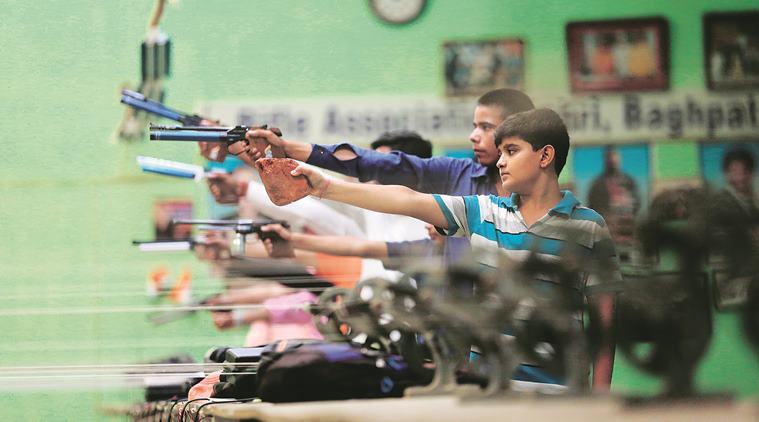 At the Johri academy. Roughly 35 such academies have mushroomed across Baghpat in the last two decades. (Express photo by Tashi Tobgyal)
At the Johri academy. Roughly 35 such academies have mushroomed across Baghpat in the last two decades. (Express photo by Tashi Tobgyal)
Within a year, Doli won several district-level and inter-village titles. This year, she is expected to take part in her first national inter-school meet. Her father Sanjay, 40, says the neighbours taunt him for letting his daughter “do what the men do”. “They weren’t comfortable that we got our daughter to hold a pistol and travel to other cities alone. The thinking here is very old-fashioned,” he laughs. “But we want to make our daughter an international shooter.”
If the girls here hope to compete globally, the boys get into shooting hoping to land a job in the Army. It’s an obsession stemming from deeply ingrained ideas of patriotism associated with an Army job, besides the lure of a secure job.
Prince Bharadwaj, 11, travels 100 km back and forth every day from Loni near Ghaziabad to the Baghpat range in Johri. Like Doli, he too is inspired by Chaudhary’s Asian Games medal. But he isn’t consumed by the dream to represent the country. “It’s ok if I don’t become a big international shooter. I just want to join the Army,” he says.
***
While these aspirations reflect the popularity of the sport, scratch the surface and grim realities emerge.
In 2013, a key policy decision by the government played its part in encouraging youngsters to take up shooting as a sport. That year, for the first time since 1951, the Arms Act was amended to relax norms — any aspiring shooter above 12 was now allowed to apply for an arms licence.
The Act allows Indians to own guns for three primary reasons: self-defence, crop protection and sport shooting. The licence under the sports quota is exempted from import duty, which reduces prices considerably. This has given rise to a huge black market, where ‘sport shooters’ procure weapons at concessional rates from abroad and sell it for four or five times the amount to someone without an import licence.
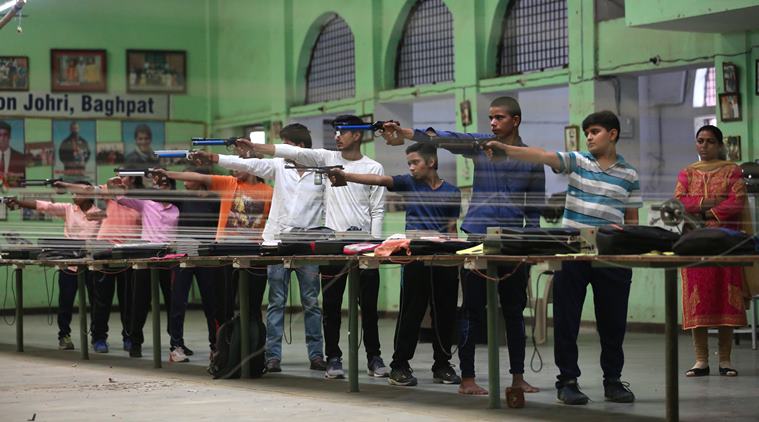 Young boys and girls mainly from the fringes of the local society, practise shooyting with air pistols at the Sports Authority of India- Rifle association of India Range in Jauhadi in the Meerut region, India. (Express Photo by Tashi Tobgyal New Delhi)
Young boys and girls mainly from the fringes of the local society, practise shooyting with air pistols at the Sports Authority of India- Rifle association of India Range in Jauhadi in the Meerut region, India. (Express Photo by Tashi Tobgyal New Delhi)
Around the same time, in UP, as the state recovered from the Muzaffarnagar riots, the government ordered district administrations in riot-hit areas such as Muzaffarnagar, Shamli and Baghpat, to be stricter with background checks while granting licences.
“That made it almost impossible for a civilian to get an arms licence. So the next best way to get one was to be a sport shooter. That’s why you see hundreds of shooters from UP taking part in the nationals,” says a rifle shooter from Muzaffarnagar.
In June 2017, the Directorate of Revenue Intelligence (DRI) arrested Prashant Bishnoi, a national-level shooter from Meerut, in one of the biggest arms and wildlife trophies seizure cases. Bishnoi was accused of being the kingpin of a global racket in which hundreds of illegally imported firearms, 117 kg of nilgai meat, horns and skin of leopards and blackbucks, apart from Rs 1 crore in cash, were recovered.
Bishnoi was a ‘renowned shooter’ as defined by the National Rifle Association of India. It essentially means that at a national championship, he shot a score (pre-decided by the NRAI) which made him eligible for an import licence under the sports quota.
As is the policy, Bishnoi could buy up to seven weapons — four related to his event and three other weapons. But he allegedly hoodwinked the customs and managed to smuggle dangerous firearms with the help of a Slovenian national. The DRI suspects other national-level shooters to be involved in this racket. The investigation is still on.
Various rifle club associations across western UP acknowledge this as a problem.
“You can get a rifle for Rs 2 lakh and sell it for Rs 10 lakh or more. It’s a huge racket,” says a member of the Muzaffarnagar rifle club, before insisting that “only 10 per cent people would get into illegal activities.”
 Walls of the Sports Authority of India- Rifle association of India Range in Jauhadi in the Meerut region, India. (Express Photo by Tashi Tobgyal New Delhi)
Walls of the Sports Authority of India- Rifle association of India Range in Jauhadi in the Meerut region, India. (Express Photo by Tashi Tobgyal New Delhi)
Many such as Khan, the former India shotgun shooter, singles out Bishnoi as a “rare” case and says the problem isn’t as big.
“Shooting is a good outdoor activity, as I see it. You teach your children responsibility, safety and respect for guns. That’s what I learnt from my father, whom I used to accompany for hunting. And I pass these values on to my children on the shotgun range,” he says.
***
Nitu Sheoran, a coach at the Johri shooting range, insists the sport has brought about social change. Sheoran was one of two women who joined the Johri academy when it was opened in 1998. “The other girl was Seema Tomar (not to be mistaken with the current India shooter, who too is from the same village). We were both criticised but gradually, we saw the change,” Sheoran says.
One such “change” was that they were no longer harassed by the men in the village. “We didn’t take up shooting as a self-defence thing, but the boys had begun to think, ‘yeh shooting waali hai, isko mat karo kuch (she is a shooter, don’t mess with her)’. So that prompted many girls to join the academy,” says Sheoran, who now lives in Meerut.
Since last year, the Johri academy has stopped recruiting boys. “The boys have plenty of ranges. We want to make this a place where women can come and shoot without fear of being judged,” says Sheoran.
It’s the beginning of another revolution in Johri. Twenty years after the first began.
***
The big guns
Saurabh Chaudhary, 16
Event: Pistol
2018 Asian Games gold, junior world champion, junior world record holder
Seen as the next big thing in Indian shooting, Saurabh hails from Kalina village in Meerut. He began shooting just three years ago by constructing a makeshift range at his home
Shardul Vihan, 15
Event: Shotgun
2018 Asian Games silver medal
The Asian Games was his senior international debut, where he won a silver in double trap. Coached by Olympian Anwar Sultan, at 14, Shardul, who is from Shamli, was crowned the national champion in junior and senior double trap events
Shapath Bharadwaj, 15
Event: Shotgun
World Cup bronze medalist
At 14, he was selected for India’s World Cup team, which made him the youngest shooter to compete internationally for the country. From Meerut, he travelled daily to Delhi’s Dr Karni Singh Shooting Range, where he was monitored by former world record holder Ronjan Singh Sodhi
Ravi Kumar, 28
Event: Rifle
2018 Asian and Commonwealth Games bronze medalist
From Meerut, Ravi trained for a while at the shooting academy in Johri from where he was picked up by the Air Force. He recently won medals at the Asian and Commonwealth Games
Seema Tomar, 36
Event: Shotgun
World Cup silver medalist, 6-time national champion
Seema, who hails from Baghpat, is an expert in shotgun. Now with the Indian Army, she is one of the most experienced shooters in the Indian team
***
The others
Morad Ali Khan (shotgun) — From Muzaffarnagar, he won India’s first-ever shooting gold in 1995. Won Arjuna award in 1996
Anwar Sultan (shotgun) — From Shamli, competed at the Sydney Olympics in 2000
Sheeraz Sheikh (shotgun) — From Meerut, he is India’s top-ranked skeet shooter now
Mohd Asab (shotgun) — Also from Meerut, he won a double trap bronze at the Glasgow CWG
Saniya Sheikh (shotgun) — A third generation shooter from Meerut, Saniya’s father Mohd Sualeyheen Sheikh, also her coach, was an international shooter. Won two senior national titles and seven-time national junior skeet shooting champion




















